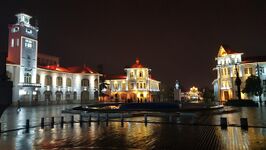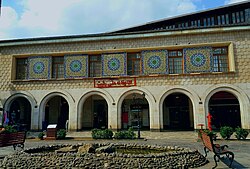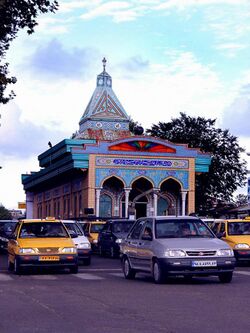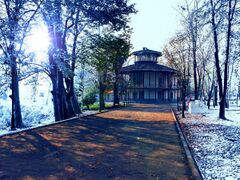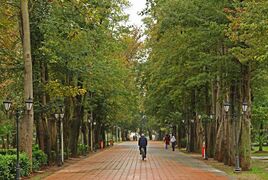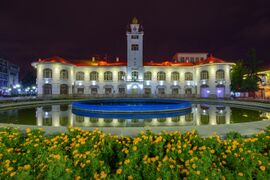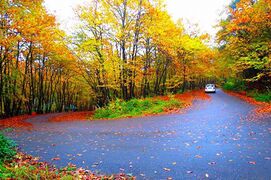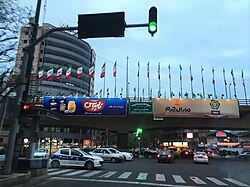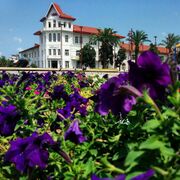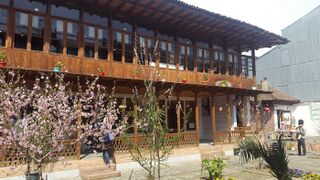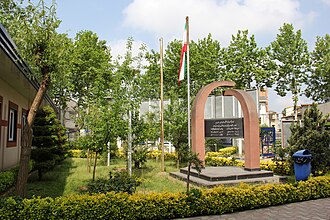Place:Rasht
Rasht | |
|---|---|
City | |
Municipal hall at night, Mirza Koch tomb, Saint Mesrop Church, Kolah Farangi mansion, Gilan Rural Heritage Museum, Gulzar bath, National library. | |
| Nicknames: Rain City, Rasht-Heaven | |
| Coordinates: [ ⚑ ] : 37°16′28″N 49°35′20″E / 37.27444°N 49.58889°E[1] | |
| Country | Iran |
| Province | Gilan |
| County | Rasht |
| District | Central |
| Government | |
| • Mayor | Rahim Shoghi [2] |
| • City Council Chairman | Mohammad Hossein Vasegh Kargarnia |
| Area | |
| • Total | 102 km2 (39 sq mi) |
| Population (2016)[3] | 679,995 |
| Time zone | UTC+3:30 (IRST) |
| Area code(s) | 013 |
| Website | rasht |
Rasht (Persian: رشت, romanized: Rašt [ɾæʃt] (![]() listen); Template:Lang-glk)[4][lower-alpha 1] is a city in the Central District of Rasht County, Gilan province, in Iran. The city serves as the capital of the district, the county and the province.[5] The city is also known as the "City of Rain" (شهر باران, Script error: The function "transl" does not exist.) and, with a population of 679,995 in 2016,[3] is the most populous city of northern Iran.
listen); Template:Lang-glk)[4][lower-alpha 1] is a city in the Central District of Rasht County, Gilan province, in Iran. The city serves as the capital of the district, the county and the province.[5] The city is also known as the "City of Rain" (شهر باران, Script error: The function "transl" does not exist.) and, with a population of 679,995 in 2016,[3] is the most populous city of northern Iran.
Rasht is the largest city on Iran's Caspian Sea coast. Due to being between the coast and the mountains, the local environment is rainy with humid subtropical and mediterranean influences. It also has temperate rainforest to its south, contrasting to the mostly arid Iran.
It is a major trade center between Caucasia, Russia , and Iran using the port of Bandar-e Anzali. Rasht is also a major tourist center with the resort of Masouleh in the adjacent mountains and the beaches of Caspian as some of the major attractions.
Historically, Rasht was a major transport and business center which connected Iran to Russia and the rest of Europe, and because of this was known as the "Gate of Europe". The city has a history that goes back to the 13th century but its modern history dates back to the Safavid era during which Rasht was a major silk trade center with numerous textile workshops. In 2015, this city joined the network of creative cities of the world as a creative gastronomy city under the supervision of UNESCO.
History
Timeline
- 682: Rasht was first mentioned in Umayyad historical documents.
- 1669: Stenka Razin, a Cossack warlord, plundered the city.
- 1714: Rasht destroyed by earthquake.
- 1722–1732: Occupation by the Russians due to the Russo-Persian War.
- 1901: A major epidemic plague devastates the city.
- 1917–1920: The Russian and British armed forces fight in the port city of Bandar-e Anzali and Rasht. The British retreat and the Russians occupy the area.
- 1920–1921: The short-lived Gilan Soviet Socialist Republic was established with its capital in Rasht.
- 1937: A revolt, sparked by the desire to collect a "road tax" from the Russians, was suppressed.
- 1974: First university established in Rasht.
Rasht was first mentioned in Umayyad historical documents in 682 CE, but it is certainly older than this and appears on the Peutinger Map of late antiquity. It has seen the Sassanid era, the Rashidun conquest, the armies of Peter the Great and later Russian rulers, and British colonialism. The people of Rasht also played a major role in the Constitutional Revolution of Iran.
The name Rasht comes most plausibly from the verb Script error: The function "transl" does not exist., weaving. Rasht has, along with regions around Tabriz and Tehran, one of the earliest industry plants during the last quarter of the 19th century, prominently in fields such as fishing, caviar production, the Caspian sea oil pipeline construction and textiles. During the 20th century, until the mid-70s, Gilan and the Rasht region was the third-ranking industrial city in Iran by number of workers and per capital productivity. It lost its cultural and industrial status to a large extent after the 1970s.
The people of Rasht played a prominent role in instigation and radicalization of the Persian Constitutional Revolution (1905–1907). Rasht is the birthplace of Mīrzā Kūchak Khān, one of the leading figures of the Constitutional Revolution. His own movement in Gilan, which went by the name of Jangalis, represented a pro-modern and social democratic program for reformation of Muslim rituals and traditions. Mirza established the short-lived Persian Socialist Soviet Republic in 1920 after the defeat of the constitutional forces and in coalition with Iranian communists.
The republic had the support of the newly established Russian Red Army. The Soviet Government, after a turn of military and political strategy proposed by Trotsky, withdrew its support and the republic itself was tormented by the inner conflicts between the newly established Iranian Communist Party (1919) and the Jangalis and other factions. The republic was finally defeated by the Iranian army under the command of Reza Shah.
The first national library of Iran was established in Rasht under the Qajar dynasty. Nasim-e-Shomal, the first[citation needed] modern newspaper of Iran after the constitutional revolution, has been initially published in Rasht. First Public Library of Iran was built in Rasht City.[3] First Branch of the First Iranian Bank (Sepah Bank) was located in Rasht City.[6] First branch of 24/7 pharmacy (Karoon pharmacy) was built in Rasht City. First school for girls and first fire station in Iran were also built in Rasht City. The city of Rasht was the center of Gilan and the center of the first province of the country.
During the Qajar period, along with economic development between Iran and Russia, Noghan trade and other products expanded. Thus, Rasht became the gateway to Europe in the 19th century. Grigoriy Melgunov (ru), a Russian orientalist and writer who visited Rasht at the end of 1860, wrote in his published notes that the city at that time had 5463 houses, 1021 shops, 22 mosques, 34 schools and 17 bathhouses, and a population of 27,314.[7] At that time, Rasht's political credibility was such that the Russia n, United Kingdom , and Ottoman governments had consulates in Rasht.[8]
Modern day
Rasht is turning into an industrialized town like most of the Iranian large cities and province capitals. Enjoying the Kadus International Hotel and hundreds of tourist attractions, Rasht receives thousands of foreign tourists annually, mostly from Austria, Germany , Netherlands, France , Australia , Japan and African countries like Senegal and Cameroon as well as countries from Oceania like Micronesia.
Rasht is known for its famous municipal building, located in the Square of Municipality, which was constructed circa 1900, and has been renovated each year. Due to the high amount of humidity in Rasht which damages and destroys the aged buildings, the native, older architectural texture of Rasht is gradually being replaced with the modern skyscrapers and apartments.
The culture of consumerism is prevalent among the people of Rasht as a cultural and urban center which is historically engaged in close commercial and political ties with the United Kingdom , Russia and France . Due to this background which makes the inhabitants much familiar with the industrial, cultural and political developments of the west, the finance and credit institutions are more willing to open representative offices and bureaus in Rasht and it has made the city a center of various banks and financial organizations.
There are many commercial centers, malls and financial institutions in Rasht including one branch of the Exports Development Bank of Iran which is an international bank dealing with the Iranian exports. The organizers and directors of national Iranian or non-Iranian banks afford to spend considerable amounts of budgets to construct attractive and modern buildings for their offices in Rasht.
File:Panorama of boosar neighberhood in Rasht.tif
Since the Islamic Revolution of 1979 in Iran, there have always been requests on behalf of Russian, Turkish and Azeri banks to open branches in Rasht and that is why the city is endowed as the "gate of Europe" in Iran. The head consulate of the Russian Federation government is located in Rasht and some of the other Caspian region countries are also keen to establish representative headquarters in Rasht alongside their embassies in Tehran.
Some evidences are the University of Gilan which was constructed jointly by the governments of Iran and West Germany about 40 years ago, the building of IRIB representatives in Rasht which was constructed jointly by the Iranian and Belgian engineers.
First of Iran
- The first branch of Bank Sepah and first Bank of Iran was established in Rasht in 1925[9]
- The first girls' school in Iran was established in Rasht[10][11]
- The first day & night pharmacy in Iran was established in Rasht[12]
- The first sanatorium for the elderly and disabled in Iran was established in Rasht[13]
- The first National Library of Iran was established in Rasht in 1920[10]
- The first bus Iran arrived in Rasht[14]
- The first city in which the sewage system was established
- The first city in which the Russia n, United Kingdom , France and Ottoman governments opened their consulates and had political representatives.[10]
- The first silk factory in Iran[15]
- The first national hospital in Iran named Poursina Hospital[16]
- The first classical theater in Iran[17]
Streets and boulevards
- Golsar Street
- Imam Ali Boulevard
- Shahid Chamran Boulevard
- Ayatollah Taleghani Boulevard
- Resalat Street
- Shohaday-e Gomnam Boulevard
- Ostadsara Street
- Esteghamat Street
- Deylaman Boulevard
- Moallem Boulevard
- Imam Khomeini Boulevard
- Valiasr Street
- Enghelab Street
- Azadi Street
- Azadegan Boulevard
- Shahid Ansari Street
- Farhang Street
- Parastar Boulevard
- Bastani Shoaar Street
- Afakhra Street
- Pasdaran Street
- 22 Bahman Boulevard
- Alamolhoda Street
- Saadi Street
- Tohid Street
- Navab Street
- Gilan Boulevard
- Gholipour Boulevard
- Habibzadeh Boulevard
- Ansari Boulevard
- Suleman Darab Boulevard
- Takhti Street
- Bisotun Street
Climate
Rasht has a humid subtropical climate (Köppen: Cfa, Trewartha: Cf). The climate is one of the wettest in Iran, with warm summers and cool winters, sometimes with snow.[18] The average humidity is above 80%, contrasting heavily with cities in many other parts of Iran. Sunshine hours, averaging roughly 1,700 per year, is lower than in most places in Iran and also compared to most places at this latitude. Rasht is also known as "The City of Rain".Script error: No such module "weather box".Script error: No such module "weather box".
- ↑ Afternoon humidity measured at 09:00UTC.(12:30 IRST)
Demographics
Population
| Historical population | ||
|---|---|---|
| Year | Pop. | ±% p.a. |
| 1986 | 290,897 | — |
| 1996 | 417,748 | +3.69% |
| 2006 | 551,161 | +2.81% |
| 2011 | 639,951 | +3.03% |
| 2016 | 679,995 | +1.22% |
| source:[21] | ||
The city of Rasht is the most populated city in the north of the country and one of the metropolises of Iran. At the 2006 National Census, its population was 551,161 in 159,983 households.[22] The following census in 2011 counted 639,951 people in 204,054 households.[23] The latest census in 2016 showed a population of 679,995 people in 228,142 households.[3]
Language
People of Rasht are mostly Gilaks (98/2%) and they speak Rashti variety of Western Gilaki language.[24][25][26][27] [28] [29]
Culture
People of Rasht spend much on arts, food, and clothes. They spend the leisure times going to cinemas, art exhibitions, music concerts and international book fairs that are being held in the city most of times in a year. Also the municipality kicks off sports, cultural or IT-related competitions to involve the youth in healthy and constructive activities. The most beloved competition is the annual blogging competition which awards the top young bloggers each year.
Rasht has been playing a major role in Iranian history. It was Iran's gateway to Russia and Europe; therefore it was influenced by western architecture. Iran's first public library was built here and it was the first city in Iran where girls were allowed to go to school.
Iranian cities of Isfahan and Rasht were accepted to the UNESCO Creative Cities Network on December 11, 2015. Isfahan is registered because of its creative crafts and folk art; and Rasht because of its unique gastronomy.[30] Rasht embroidery is a handicraft and art specific to the city and Gilan province.[31][32]
On 4 January 2015, Rasht was selected as the political center of Gilan more than 4,500 years ago. The date 4 January was then included in the official calendar of the country as Rasht Day.
Cuisine
The dominant foods of Rasht people are various types of fish. Mirza Ghassemi, vavishka (a type of haggis), nargesi, baghala ghatogh, and ashpal (roe) are some other popular local dishes. Reshteh khoshkar is a well-known sweet. Zeitoun Parvardeh is a kind of delicacy prepared from olives and pomegranates; it is a popular seasoning in the city.[33]
Rose de Rescht
Rosa 'de Rescht', like many old garden roses, presents an interesting historical background story. This cultivar, originating in Iran, was reported at the end of 19th century in England, but it was then forgotten. It was rediscovered near the Iranian provincial capital of Rascht by Miss Nancy Lindsay in 1945, and was brought back to the United Kingdom, where it was re-introduced around 1950. Today it is shown in the Victorian Class, winning many trophies.[34]
Sports
The people of Rasht have always been regular fans of football which is the beloved sport in the city. Most are fans of Damash Gilan who play in the Azadegan League or Sepidrood Rasht who play in the Persian Gulf Pro League. Damash Gilan is the newer version of former Pegah football club that belonged to the municipality of Rasht, but was purchased later by the mineral water factory of Damash and changed its name and properties to Damash Gilan.
The home stadium of Damash Gilan is Dr. Azodi Stadium which is an old stadium dating back to almost 40 years ago and its capacity is 11,000 people. Sardar Jangal Stadium is the city's second stadium.
Following football, wrestling, judo and weightlifting are the most popular sports of youth in Rasht and that is due to the enchanting appearance of Iranian wrestlers and weightlifters in the international competitions like Olympics. The outstanding figure of world weightlifting and the two-time olympics Gold medal winner Hossein Rezazadeh is a main inspirer of Rasht youth to try Weightlifting as their professional job. Asghar Ebrahimi who was the squad captain of Iranian weightlifting team at the 2008 Olympics is from Rasht and a successful example of those youth from Rasht who tried this national field of sport after Hossein Rezazadeh.
Colleges and universities
- University of Gilan
- Gilan university of medical sciences
- Islamic Azad University of Rasht
- Jaber ebn Hayyan Institute of Higher Education
- Payame Noor University
- Institute of Higher Education for Academic Jihad of Rasht
- Guilan Technical & Vocational Training Organization[35]
- Gilan Advanced Skills Training Center[36]
- Rasht Technical and Vocational Institute[37]
- Guilan University of Applied and Scientific Technology[38]
Economy
This city is greatly important based on its geographical situation (locating on the central plain and its large width, fertile lands and soil, being the most important region of the province and Iran in terms of rice cultivation), communicative situation (locating among Tehran–Qazvin-Anzali-Astara roads, in one hand, and the main road from Gilan to Mazandaran and the east of Gilan, on the other hand), political–administrative situation (situating as the capital city of Gilan province) and economic development, towns expansion and industrial factories and the following increase in the agricultural-commercial activities and in the number of science and technology centers.
The most residents of this city are active in service, trading and industrial jobs and paddy is the main activities of the villagers in this region.[39][40][41] Rasht has long been one of the most prominent customs cities in Iran. This city used to be the only communication and trade route of Iran to Europe through the Anzali port. From the time of Shah Abbas II until the end of the Qajar rule, the city of Rasht was a large commercial center, and caravans stopped in this city to buy silk and sell their goods from In this way, they were sent to the ports of the Mediterranean Sea.
The presence of the Russian Consulate and then the British Consulate in Rasht caused the economic and social prosperity of this city, and there was a representative of the Ministry of Foreign Affairs or a broker, a Russian consul, a French deputy consul, and a British deputy consul in this city, and apart from The ruler of Rasht, the agent of foreign affairs was also stationed in Rasht on behalf of the central government. During this period, Tomanians Russian Borrowing Bank and Trading House were active in Rasht consecutively.
At the same time, Rasht's foreign trade developed and most Rashtites became millionaires, and Rasht became an aristocratic city during the Qajar period. The city is served by Refah Chain Stores Co., Iran Hyper Star, Isfahan City Center, Shahrvand Chain Stores Inc., Ofoq Kourosh chain store.
Pharmaceutical industry
At present[when?], Rasht has a Faculty of Pharmacy under the auspices of Gilan University of Medical Sciences and several drug production centers, one of which is a center for the production of anti-cancer nano-drugs with 24 pens. Sobhan Daroo Co. is one of the most successful pharmaceutical companies in Iran. And with more than 100 production licenses, it is currently the second largest producer in the country in terms of production volume. Sobhan Oncology Pharmaceutical Company is one of the most modern and advanced production units of anti-cancer and chemotherapy products in the world.[42]
Health centers and hotels
Hotel
Hospital
Transportation
Taxi
In 1947, 50 taxis were purchased from England by the order of Fakhr-ol-dowleh (daughter of Muzaffar al-Din Shah) and imported to Iran. In 1948, the first taxi entered Rasht by crossing the main street of the city due to his interest in Gilan. Rasht Metropolitan Taxi Organization has so far organized more than 9,500 taxis and private cars.
Railway
Rasht is served by Rasht railway station. There are daily train departures from Tehran to Rasht, leave Tehran at 07:45 and arrive Rasht in 13:10. The non-reduced ticket price costs 430,000 Rials (2 euros 50 cents in May 2019) and can be bought either online from the Iranian railway website or in travel agencies. The railway passes through Alborz mountains and then Sefidrood river valley and stops in Karaj and Qazvin on its way to Rasht.
International airport
The Rasht International airport is the only airport in the small province of Gilan and was established in 1969 with an approximate area of 220 hectares. At first, the airport just handled domestic flights to Tehran and Mashhad, but after it was renamed to Sardar Jangal International airport in 2007, additional routes were established.
The airport is in close affiliation with hundreds of flights by national and international airlines, including Mahan Air, Iran Air, Iran Aseman Airlines, Kish Air and receives more than 2000 flights annually.
Historical and natural attractions
- Municipal Complex
- Iran Hotel
- Post Building
- National Library
- Tomb of Mirza Kuchak Khan
- Mirza Kuchak Khaan House
- Safi Mosque
- Kolah Farangi Mansion
- Sabzeh Meydan Park
- Gilan Rural Heritage Museum
- Saravan Forest Park
- Gilan Rural Heritage Museum
- Rasht Museum of Anthropology
- Avanesian House
- Rasht Grand Market
- Hajj Samad Khan Mosque
- Haj Samiee Mosque
- Badyollah Mosque
- Qadiri House of Rasht
- Mirza Khalil House
- Governor's Building
- Mohtasham Garden
- Mafakher Park
- Emamzadeh Hashem
- Imamzadeh Ismail and Abbas
- Mellat Park
- Eynak Lagoon
- Keshavarz Park
- Meshkat Park
- Towhid Park
- Golshan Mosque
- Kase Forushan Mosque
- Zargaran Mosque
- Abrishamchi House
- Ashkouri House
- Seyyed Ali Moghimi House
- Mohtasham Caravanserai
- Haji Bath
- Ebrahim Pourdavoud Tomb
- Chomarsara Clay Bridge
- Gishe Damerdeh Bridge
- Gurab-e Lishavandan
- Tomb of Imam's sister
- Imamzadeh Bibi Zeynab
- Tomb Tower Danaye Ali
- Siah Estalakh Village
- Lat Carvansary
- Shahid Beheshti High School
Notable people
- Hushang Ebtehaj The intellectual poet of 20th century in Iran
- Hossein Sami'i (1876 – 1953) Iranian writer, poet, diplomat and politician
- Mirza Kuchik Khan One of the martyrs of freedom in Iran
- Aydin Aghdashloo (1940) Iranian painter, graphist and art curator
- Reza Baluchi (Born 1972) athlete
- Mahmoud Behzad The father of modern biology of Iran
- Mir Abdolrez Daryabeigi Painter
- Mohammad Bagher Nobakht Iranian politician and economist
- Fathollah Khan Akbar Iranian Prime Minister
- Amir Eftekhari Footballer
- Khosrow Golsorkhi Journalist, poet, and communist activist
- Hadi Jelveh Associate Justice of the Iran Supreme Court
- Alexander Kasimovich Kazembek Orientalist, historian and philologist
- Mohammad Khatam Iranian air force commander and advisor to the Shah
- Hamideh Kheirabadi Former Actress
- Arsen Minasian The Armenian founder of the first modern sanatorium in Iran
- Mohammad Moein Linguistics and literature researcher
- Ardeshir Mohassess Cartoonist
- Youcef Nadarkhani Christian pastor sentenced to death for apostasy from Islam
- Mahmoud Namjoo The world's weightlifting champion
- Ardeshir Ovanessian Communist leader
- Mohammad Nouri Singer
- Kazim Rashti He was a Shaykhi scholar
- Ebrahim Poordavood Academic
- Dariush Ramezani Cartoonist
- Fazlollah Reza Former Iran's ambassador to UNICEF and former manager of Sharif University
- Anoushiravan Rohani Musician
- Massoumeh Seyhoun Painter
- Sadeq Saba Head of BBC Persian Service
- Majid Samiei Neurosurgeon and the Manager of Hanover Brain and Nerves Treatment institute
- Marjane Satrapi World award-winning film director
- Susan Taslimi Actress
- Yahya Rahmat-Samii Northrop Grumman chair professor
- Farideh Lashai Painting
- Homayoon Toufighi Iranian chess grandmaster
- Houchang Nahavandi Iranian professor
- Habib Nafisi Engineer
- Houman Seyyedi Iranian actor and director
- Shohreh Bayat Iranian chess arbiter
- Asghar Ebrahimi Iranian weightlifter
- Mahmoud Etemadzadeh Writer
- Enayatollah Reza Iranian historian
- Reza Ramezani Gilani Muslim cleric
- Esmaeil Elmkhah Iranian weightlifter
- Nasrollah Moghtader Mojdehi Iranian professor
- Mohammad Tolouei Writer
- Asghar Kardoust Basketball player
- Mohammad Rahbari Fencer
- Babak Zarrin Composer
- Mohsen Forouzan Footballer
- Hadi Tabatabaei Footballer
- Saeid Hassanipour Karateka
Distance to major cities
| City | Km distance |
|---|---|
| Isfahan | 640 |
| Tehran | 326 |
| Kerman | 1250 |
| Mashhad | 1063 |
| Tonekabon | 137 |
| Amol | 295 |
| Shahrekord | 739 |
| Ahvaz | 956 |
Twin towns – sister cities
Rasht is twinned with:[43]
 Astrakhan, Russia
Astrakhan, Russia Moscow, Russia
Moscow, Russia Multan, Pakistan
Multan, Pakistan Trabzon, Turkey
Trabzon, Turkey
Notes
References
- ↑ OpenStreetMap contributors (6 October 2023). "City, Rasht County" (Map). OpenStreetMap. Retrieved 6 October 2023.
- ↑ "خبرگزاری فارس - رحیم شوقی رسماً شهردار رشت شد". 4 May 2023. https://www.farsnews.ir/news/14020214000089/%D8%B1%D8%AD%DB%8C%D9%85-%D8%B4%D9%88%D9%82%DB%8C-%D8%B1%D8%B3%D9%85%D8%A7%D9%8B-%D8%B4%D9%87%D8%B1%D8%AF%D8%A7%D8%B1-%D8%B1%D8%B4%D8%AA-%D8%B4%D8%AF.
- ↑ 3.0 3.1 3.2 "Census of the Islamic Republic of Iran, 1395 (2016)" (in fa) (Excel). The Statistical Center of Iran. p. 01. https://www.amar.org.ir/Portals/0/census/1395/results/abadi/CN95_HouseholdPopulationVillage_01.xlsx.
- ↑ Rasht can be found at GEOnet Names Server, at this link, by opening the Advanced Search box, entering "-3080876" in the "Unique Feature Id" form, and clicking on "Search Database".
- ↑ Habibi, Hassan (21 June 1369). "Approval of the organization and chain of citizenship of the elements and units of the national divisions of Gilan province centered on the city of Rasht" (in fa). Ministry of Interior, Defense Political Commission of the Government Board. https://rc.majlis.ir/fa/law/show/113040.
- ↑ [1]
- ↑ Melgunov, Grigoriy (1863) (in ru). Saint Petersburg: Printing Office of the Imperial Academy of Sciences. pp. 220–221. http://elib.shpl.ru/ru/nodes/71217-melgunov-g-v-o-yuzhnom-berege-kaspiyskogo-morya-spb-1863.
- ↑ The Adventures of a Frenchman in Rasht / Jean-Baptiste Nicola
- ↑ "History of the first Iranian bank". https://www.banksepah.ir/161/History.aspx.
- ↑ 10.0 10.1 10.2 RASHT i. The City / Encyclopædia Iranica
- ↑ "Rasht city of silver rain". 30 June 2019. https://en.mehrnews.com/news/147013/Rasht-city-of-silver-rain.
- ↑ "تاریخچه اولین داروخانه شبانه روزی ایران". https://afragostarco.com/index.php/%d9%85%d8%b7%d8%a7%d9%84%d8%a8-%d8%a2%d9%85%d9%88%d8%b2%d8%b4%db%8c/292-%d8%aa%d8%a7%d8%b1%db%8c%d8%ae%da%86%d9%87-%d8%a7%d9%88%d9%84%db%8c%d9%86-%d8%af%d8%a7%d8%b1%d9%88%d8%ae%d8%a7%d9%86%d9%87-%d8%b4%d8%a8%d8%a7%d9%86%d9%87-%d8%b1%d9%88%d8%b2%db%8c-%d8%a7%db%8c%d8%b1%d8%a7%d9%86.
- ↑ Janet D. Lazarian (2003). Encyclopedia of Iranian Armenians. Tehran: Hirmand Publisher. pp. 301–302. ISBN:964-6974-50-3.
- ↑ "اولین اتوبوس وارد شده به ایران". 24 April 2013. https://www.jahannews.com/gallery/283135/1/%D8%A7%D9%88%D9%84%DB%8C%D9%86-%D8%A7%D8%AA%D9%88%D8%A8%D9%88%D8%B3-%D9%88%D8%A7%D8%B1%D8%AF-%D8%B4%D8%AF%D9%87-%D8%A7%DB%8C%D8%B1%D8%A7%D9%86.
- ↑ History of the Russian presence in Iran / Page 395
- ↑ A Survey of Patients' Satisfaction in Emergency Department of Rasht Poursina Hospital
- ↑ "گیلان، مهد تئاتر ایران / درباره هنرهای نمایشی سرزمین هنر خیز". 3 January 2024. https://www.honaronline.ir/%D8%A8%D8%AE%D8%B4-%D8%A7%D8%AE%D8%A8%D8%A7%D8%B1-3/62039-%DA%AF%DB%8C%D9%84%D8%A7%D9%86-%D9%85%D9%87%D8%AF-%D8%AA%D8%A6%D8%A7%D8%AA%D8%B1-%D8%A7%DB%8C%D8%B1%D8%A7%D9%86-%D8%AF%D8%B1%D8%A8%D8%A7%D8%B1%D9%87-%D9%87%D9%86%D8%B1%D9%87%D8%A7%DB%8C-%D9%86%D9%85%D8%A7%DB%8C%D8%B4%DB%8C-%D8%B3%D8%B1%D8%B2%D9%85%DB%8C%D9%86-%D9%87%D9%86%D8%B1-%D8%AE%DB%8C%D8%B2.
- ↑ "Rasht, Iran Climate Summary". Weatherbase. http://www.weatherbase.com/weather/weather-summary.php3?s=407190&cityname=Rasht%2C+Gilan%2C+Iran&units=.
- ↑ "1991-2020 climate normals: Rasht, Iran". NOAA. https://www.nodc.noaa.gov/archive/arc0216/0253808/2.2/data/0-data/Region-2-WMO-Normals-9120/Iran/CSV/.
- ↑ Climatological Norms of Iran synoptic stations. Retrieved on: September 12, 2011.
- ↑ "Iran: Provinces, Major Cities & Towns - Population Statistics, Maps, Charts, Weather and Web Information". http://www.citypopulation.de/en/iran/cities/.
- ↑ "Census of the Islamic Republic of Iran, 1385 (2006)" (in fa) (Excel). The Statistical Center of Iran. p. 01. http://www.amar.org.ir/DesktopModules/FTPManager/upload/upload2360/newjkh/newjkh/01.xls.
- ↑ "Census of the Islamic Republic of Iran, 1390 (2011)" (in fa) (Excel). The Statistical Center of Iran. p. 01. https://irandataportal.syr.edu/wp-content/uploads/Gilan.xls.
- ↑ Jahangiri, Dr. Nader (in Persian). گویش گیلکی لاهیجان. Iran: Tokyo University of Foreign Studies.
- ↑ Resaei, Ayoub (2006) (in Persian), گویش گیلکی فومنات, Iran: Allameh Tabataba'i University, p. 65
- ↑ Sotoudeh, Manouchehr (1953) (in Persian, Gilaki). فرهنگ گیلکی. Iran: فرهنگ ایلیا. pp. 17, 18.
- ↑ Shokri, Giti (2006) (in Persian). گویش رامسری. Iran: پژوهشگاه علوم انسانی و مطالعات فرهنگی. p. 14.
- ↑ "Glottolog 4.6 - Western Gilaki". https://glottolog.org/resource/languoid/id/west2931.
- ↑ "Gilaki". https://www.ethnologue.com/language/glk.
- ↑ "Iran attends UNESCO annual assembly on creative cities". 4 July 2017. https://www.tehrantimes.com/news/414761/Iran-attends-UNESCO-annual-assembly-on-creative-cities.
- ↑ "رشتیدوزی از لوازم خانه تا لباس". November 21, 2015. http://modefasl.ir/%D8%B1%D8%B4%D8%AA%DB%8C%E2%80%8C%D8%AF%D9%88%D8%B2%DB%8C-%D8%A7%D8%B2-%D9%84%D9%88%D8%A7%D8%B2%D9%85-%D8%AE%D8%A7%D9%86%D9%87-%D8%AA%D8%A7-%D9%84%D8%A8%D8%A7%D8%B3/.
- ↑ "رشتی دوزی و چموش دوزی هنرهای بومی "استان گیلان"" (in fa). 2014. http://www.yjc.news/fa/news/4325063.
- ↑ "Gilan food tourism hub". 31 August 2014. http://www.iran-daily.com/News/990.html.
- ↑ "History of Rose de Rescht Rose". http://scvrs.homestead.com/RoseDeRescht.html.
- ↑ "اداره کل آموزش فنی و حرفه ای استان گیلان". http://www.guilantvto.ir.
- ↑ "مرکز آموزش مهارتهای پیشرفته گیلان". http://www.gilastc.ir.
- ↑ "دانشکده فنی و حرفه ای پسران رشت - شهید چمران". 22 December 2014. http://afr.ac.ir/home/index.
- ↑ [2][yes|permanent dead link|dead link}}]
- ↑ "Rasht". https://en.unesco.org/creative-cities/rasht.
- ↑ Economy Flights to Rasht - TripAdvisor
- ↑ Rasht Today
- ↑ History of Pharmacy in Iran
- ↑ "About city". Guilan University of Medical Sciences. http://www.gums.ac.ir/velayat/5555/About-City.aspx.
External links
| Wikivoyage has a travel guide for Rasht. |
- Rasht Municipality Organization شهرداري رشت
- Damash Rasht Football Team Fans Site
- Gilan Province
- Iran Chamber Society: Rasht
- Iran Chamber of commerce, Industries & Mines: Gilan
- Encyclopedia of the Orient
- Info Please
- Photos of Rasht in Panoramio
 |
